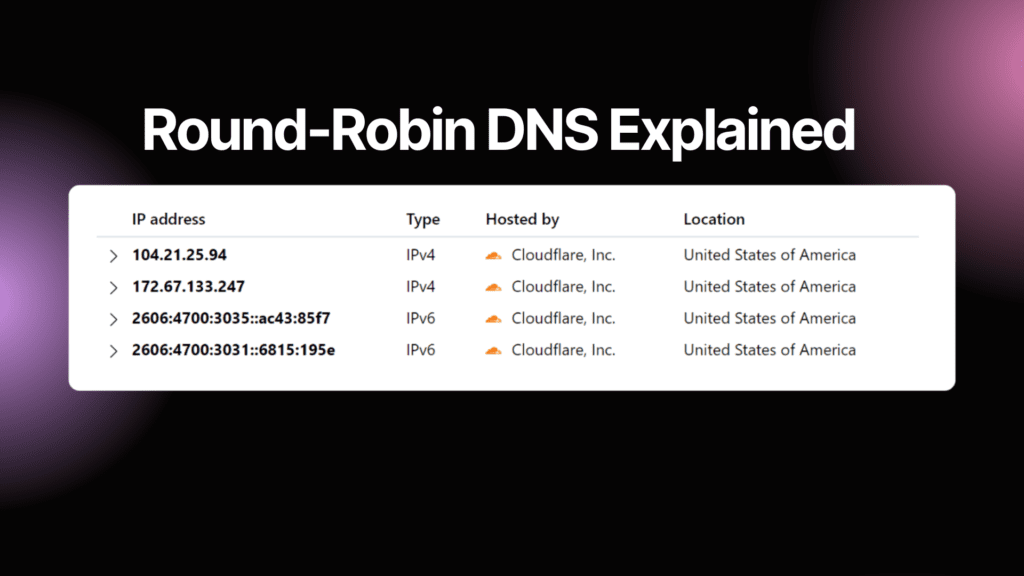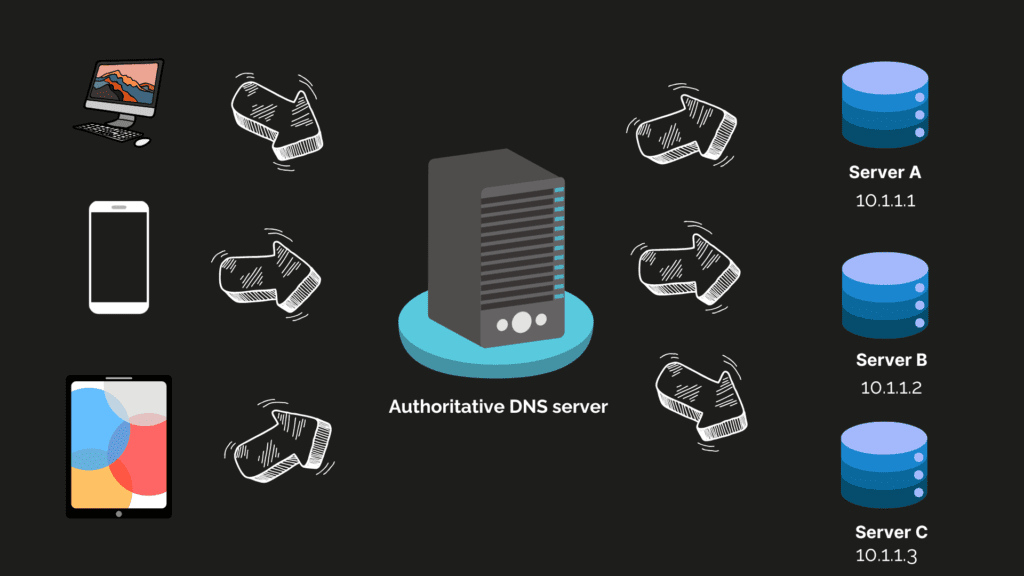
Round-Robin DNS is a load-balancing method that operates on the DNS level by distributing incoming traffic across multiple servers or IP addresses associated with a single domain name.
It plays a vital role in modern networking, particularly in scenarios where high availability, scalability, and load balancing are critical.
How Round-Robin DNS Works
- DNS Query: When a client (e.g., a web browser or application) attempts to access a website or service, it sends a DNS query to resolve the domain name into one or more IP addresses.
- DNS Server Response: The authoritative name server responsible for the queried domain name maintains a list of IP addresses associated with that domain. Instead of returning a single IP address, the DNS server cyclically rotates through the list and returns a different IP address for each subsequent query.
- Client Connection: The client receives the IP address from the DNS server and connects to the corresponding server or service using that IP address.
Read more on DNS here
The rotation of IP addresses can follow different algorithms, but the most common approach is a simple round-robin pattern, hence the name.
For example, if there are three IP addresses associated with a domain (e.g., 10.1.1.1, 10.1.1.2, and 10.1.1.3), the DNS server might return them in the following order:
- Query 1:10.1.1.1
- Query 2: 10.1.1.2
- Query 3: 10.1.1.3
- Query 4: 10.1.1.1 (back to the beginning of the list)
Benefits of Round-Robin DNS

Load Balancing and Traffic Distribution
By rotating through the list of IP addresses, the DNS server effectively distributes incoming traffic across multiple servers.
This distribution helps to balance the load and prevent any single server from becoming overwhelmed with requests, improving overall system performance and reducing the risk of downtime or service disruptions.
Availability
With Round-Robin DNS, if one of the servers or IP addresses becomes unavailable for whatever reason, the DNS server will continue to distribute traffic to the remaining active servers.
This redundancy ensures that the service or website remains accessible, even during partial system outages or server failures.
Scalability
Round-Robin DNS simplifies the process of adding or removing servers from the load balancing pool.
As the demand for a service grows, additional servers can be easily added to the DNS server’s list of IP addresses, allowing for seamless scaling without the need for complex reconfiguration or downtime.
It is cost-effective as it leverages existing DNS infrastructure and can be easily implemented.
Limitations of Round-Robin DNS
While Round-Robin DNS offers several benefits, here are some of the key limitations to consider:
Lack of Advanced Load Balancing Capabilities
Round-Robin DNS follows a simple rotation pattern, distributing traffic evenly across all available IP addresses without considering factors such as server load, performance, or geographic location.
This approach may not be optimal for scenarios that require more advanced load-balancing techniques, such as weighted traffic distribution, content-based routing, or application-level health checks.
Possibility of Imbalanced Traffic Distribution
There is a possibility of imbalanced load distribution due to factors such as client caching behaviour, network conditions, and varying request volumes from different clients.
This can lead to some servers being overloaded while others remain underutilised.
Stale DNS Records and Caching Issues
DNS records are cached by clients and intermediate resolvers to improve performance and reduce network traffic.
However, this caching mechanism can lead to stale records being used, potentially directing traffic to servers that are no longer part of the load balancing pool or have become unavailable.
Proper management of DNS record time-to-live (TTL) settings and cache invalidation techniques are crucial to mitigate this issue.
The TTL value determines how long a DNS record can be cached by clients and resolvers before it expires and needs to be refreshed.
Setting an appropriate TTL value is necessary to strike a balance between DNS performance and the ability to effect changes quickly.
A shorter TTL = faster updates but may increase DNS query load, while a longer TTL reduces query load but can delay changes.
No Built-in Failover Mechanism
While Round-Robin DNS can distribute traffic across multiple servers, it does not have an inherent failover mechanism to remove failed or unresponsive servers from the rotation automatically.
This can result in clients being directed to non-functioning servers, leading to service disruptions until the DNS records are updated manually.
How to Configure Round-Robin DNS
Round-Robin DNS functionality is typically configured at the DNS server level.
Most popular DNS server software supports Round-Robin DNS out of the box.
The configuration typically involves defining multiple “A” records (for IPv4) or “AAAA” records (for IPv6) for the domain name, each pointing to a different IP address of the servers you wish to load balance.
These IP addresses can be on the same subnet or across different subnets or data centers, depending on your network architecture and requirements.
Note that it is very important to maintain and update your DNS records regularly to ensure that the list of IP addresses reflects the current state of your server pool.